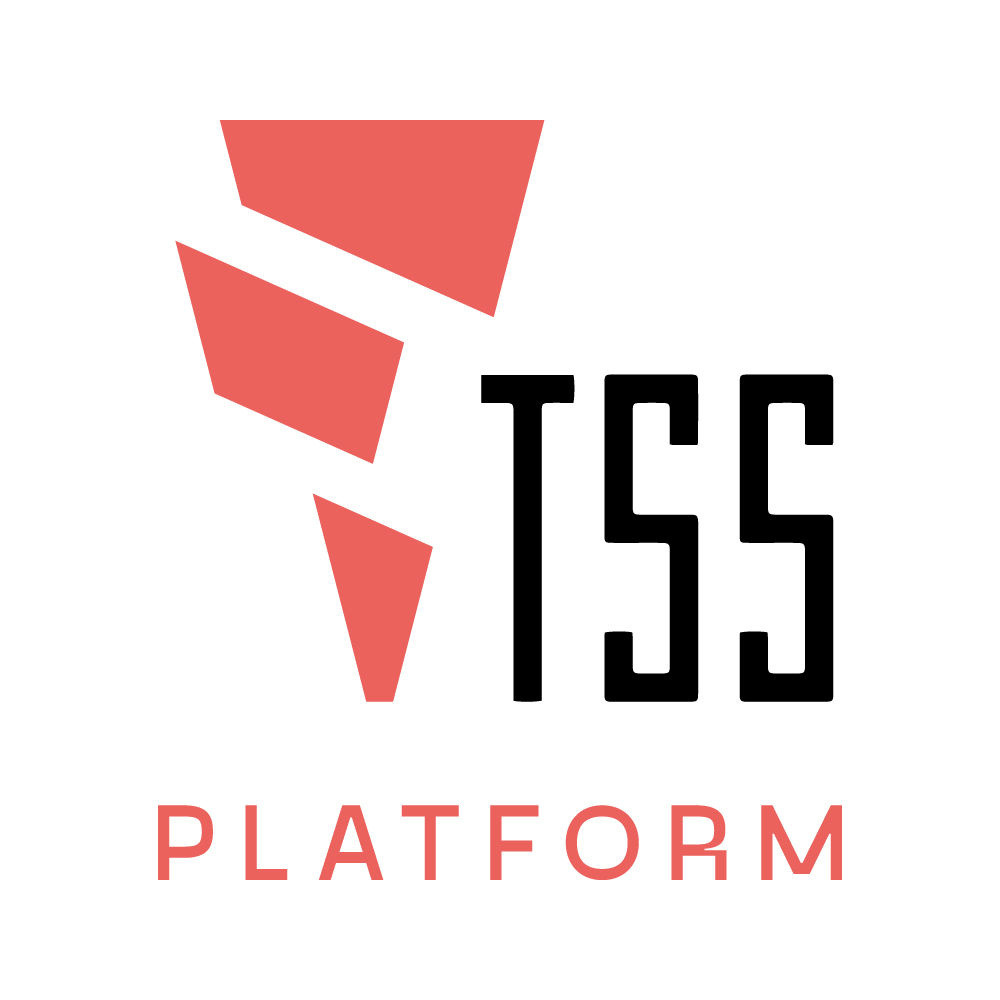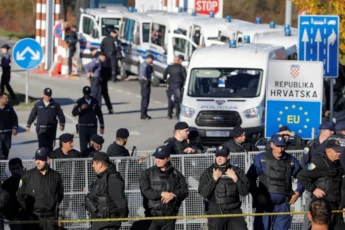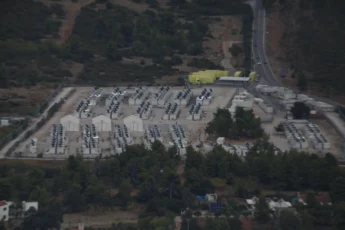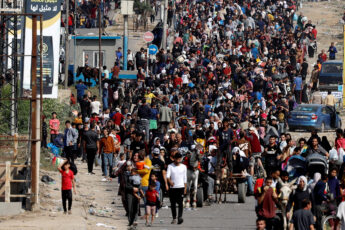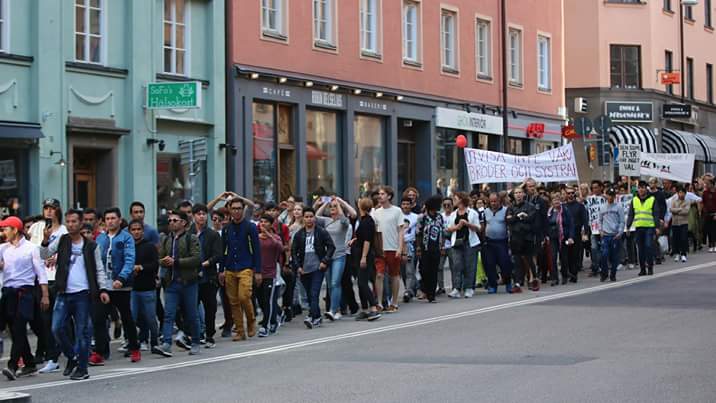
by STEVEN CUZNER (Allt åt Alla, Stockholm)
We publish a text written by Steven Cuzner from Allt åt Alla about the ongoing social strike taking place in Sweden, where thousands of young asylum seekers coming from Afghanistan are fighting since about one month to oppose the new asylum policies, which by declaring Afghanistan a safe country expose them to the constant threat of expulsion. The fact that these migrants are calling “strike” their protest is relevant for us. As Steven highlights, by striking they are not simply demanding better welcome policies or displaying their particular grievance. They are rather expressing the resolution to take back control over their lives. The strike is for them a way of practicing collectively the refusal of an imposed position, the refusal to be handled as numbers and shares by the Swedish government, to be exploited as cheap labor force or to be the scapegoats of the rising nationalist propaganda agitated in order to govern the social insecurity produced by precarity. The strike – which has involved a growing number of men and women in the last weeks – is a chance for migrants’ protagonism and a tool of political communication among different subjects hit by precarity. Its expansion into the schools is telling of its potential, as is the connection established with the garbage workers on strike. This migrants’ social strike is also able to resonate well beyond the Swedish borders: because the laws implemented in Sweden are one piece of the overall European government of mobility and because once again, by striking the borders imposed by neoliberal policies, migrants are indicating the way for all those who want to act accordingly on a transnational scale.
It was on the 6th of August. Around fifty young students from Afghanistan, facing deportation, invited people to come sit with them. Their signs were a literal invitation: “if you agree that I should not be sent to my death, come sit with me”. From the first day, they announced that this was a strike. We talked to some of the people involved, about the word strike. They said: “yeah, well, you know how a hunger strike is someone who refuses to eat? This is a strike in which we are many and we all refuse to do all the other things that are demanded of us, except sitting right here.” They have been sitting ever since. Though the location has changed. They started outside of the parliament building. A huge march through central parts of town some days later landed them on Medborgarplatsen, the very folky square whose name has a both suitable and contradictory meaning: the name translates to “Citizen’s Place”. Of course, considering the deportation threats, the majority of strikers are precisely not citizens of Sweden. But that is what they are demanding to become. By all reasonable accounts, there should be nothing standing in the way of them becoming that.
They, by the way, were not fifty youngsters for very long. By the end of the second week, they were a thousand. The location: outside of the civic hall, occupying the entirety of two giant staircases towering up to the (temporarily unused) front entrances. The growing number of strikers have now occupied this location for nearly a month, day and night. The support has been massive, sleeping necessities, food and water, have been collected in a very organised manner. The collective is entirely self organised. Several groups offer solidarity and protection, but the bulk of the work, and all decisions, are made within the collective, and communicated through representatives of the association (Ung i Sverige). Activists from other collectives, individuals wanting to offer support – as well as media – are all referred to one or several of the spokespersons. But on location, it is very evident that a large majority of the strikers are eager to talk about the demands, the strategy and the conditions they face. Most of the strikers take part of the daily assemblies in which the preferred ideas are pooled and decisions made on what to communicate.
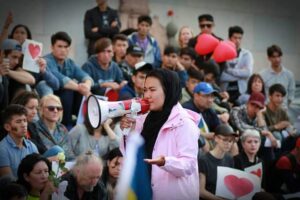
Of course, the situation in Europe today also implies that such a massive initiative taken by migrants, comes with an infuriating and sometimes physically threatening presence of ethno-nationalists who do everything they can to sabotage. Decisions made during assemblies therefore also necessarily address the tactics to be employed when racist groups are there to manifest against the Afghan youth. The tactics have been very simple – and seemingly depoliticised: hearts and Swedish flags, the evasive and conflicting word “love”, and so on. But given some understanding into the sticky European context and at times paralyzing public debate, the decisions made by the Afghan strike collective appear clever, and also clearly effective. The police gave them a full month’s authorisation to manifest (daytime only). It is likely that the police was expecting the occupation to collapse on its own. The enormous production of negative propaganda dispersed by police themselves regarding “immigrant crime” lends to the suspicion that police was calculating on that racist attacks would result in a likely defense of perhaps physical nature which at once would pan out negatively on the Afghan youths rather than on the racist aggressors. This has not happened once. Provocations are warded off in an impressive way. To an outsider, it may be frustrating to watch an ill concealed racism be met with patience, handshakes, explanations and the ever present heart signs that are waved around. But when you encounter the inverse frustration felt by the racist legions that try to sabotage the strike, it all makes sense. It hurts these nationalists to see the strikers respond with even bigger Swedish flags. Nationalists try to use as the flag as a symbolic weapon, supposedly representing some “pure” type of culture. When the refugee collective uses it on the other side, it starts to symbolise instead the nation state as nothing more than an administrative institution with responsibilities to offer asylum to persecuted individuals. The flag becomes a giant question mark: is this not an economic region fully dependent upon global affairs that create the very instability and dangers that force people to make the hazardous journey all the way here in the first place?
Overhearing conversations on the occupied steps, in this now fourth week of the strike, one gathers that many of the migrant strikers are wishing more Swedes with their legal documents in order (regardless of origin or birthplace) actually spend more time sitting with them. The scene built up is unparalleled in modern Swedish history and though it can’t be said to be surprising that many supporters limit their engagement to just passing by to take a look rather than expand the presence and help make this a lasting and effective sit-strike, it is valuable to take on the perspective of the ones who are facing deportation. The interest, expressed clearly from the onset, is to focus on placing a demand, not to solely display the grievances of a group, for people to take pity on. The leap from pity to joint struggle is difficult for many, especially as it has become customary to believe that each struggle is isolated and particular only to the very specific individuals facing a certain problem.
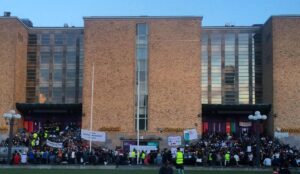
One unusual moment on a luke warm dark cloudy Saturday afternoon in mid August readily turned such notions upside down. An occurrence that surely anyone present that day would agree was like out of a feel-good historical drama cinema piece, complete with soft watery eyes and uncontrolled smiling. The local garbage collectors who earlier in the summer went out on a wildcat strike (when the company who bought the garbage service outsourced by municipal government leaked their plan to cut salaries and fire unwanted employees) were gathered on Medborgarplatsen in a manifestation to gather support. About 70 of them had taken the fight one step further and quit, taking the keys to garbage storages with them. On August 12th when they had a manifestation on the other side of the steps of the civic hall, after some great speeches, the speaker system was turned in the other direction and a representative of the Afghani strikers urged, in Dari, the several hundred migrant youth on the steps to show their support for the garbage collectors and their strike. Every one of the migrant strikers stood up and with hands above their heads applauded for minutes. Solidarity, strikers to strikers.
Since the inception, Afghani refugee youngsters have traveled from all across Sweden to take part of the sit-strike And the strike itself has been reproduced in a number of other Swedish cities. With the start of a new school semester on Monday the 21st however, many also felt compelled to return to the towns where they are registered. The organisation declared during the weekend, that strikers vowed to expand the strike into the schools. Students committed to the strike, as well as anyone wanting to act in solidarity, decided on carrying on with the strike simply by sitting on the floor during classes, at school. We are yet to see the full effects of this, but the announcement itself shows a very present ambition to incite social strike in a very tangible way. Talking to one prospective student who traveled to Stockholm from Gothenburg to participate, and who did not return for school, it becomes evident that the importance of the strike in many cases also needs to overshadow such things as school and everyday life. A young guy named Amir tells that he simply can’t focus on studies when the pending deportation is overhanging. He said that this new context on Medborgarplatsen was far too important to remain inside of. “What good are Swedish classes going to do right now, if I am sent back to military misery in Kabul some weeks, or months later?” he says (in an already considerably well spoken Swedish). When he was informed at some point by the Migration Agency, that his asylum needs do not fit the requirements, he responded that he then rather wanted to leave and try to start a life somewhere else. The funny thing, though, he added, was that they still told him to stay, and wait. “I can’t understand why so many of us are told to stay here and maybe, maybe find out that we can expect residence permits some time in the future.” It is all very vague and, indeed, difficult to understand. People become sick from waiting and not knowing.
Some puzzle pieces are maybe necessary to fit in place by looking at current fluctuations in government policies – that seem to point to an intention on the side of the government to take advantage of asylum seekers for a period, before sending them back. The employment agency, Arbetsförmedlingen, is out on a mission to find asylum seekers, through a new program called “Jobskills”. In it, they offer applicants to write CV:s in their mother tongue and translate it all for them, free of charge, and, as they say, match them with the right now immense need for workers in certain sectors. When asked if asylum seekers who are employed through this program, are entitled to regular benefits that apply to other workers, staff from the employment agency answer in an evasive manner. What we know, is that the Swedish government changed the laws very hastily in July 2016 to enforce temporary residence permits of maximum three years and minimum one year. During this period, the government now wants to take maximum advantage of newly arrived refugees and “offer” them to domestic investors seeking cheap labour power. This labour power, the asylum seeking workforce, is in that time period not granted access to law protected rights such as paid parental leave, guaranteed overtime pay, vacation pay – and a bunch of other social benefits connected to employment in Sweden. This opens a new space for employers to exploit refugees as third class workers. What previously was only, at least officially, a condition to asylum seeking workers in the “illegal” sector, is now sanctioned by the government. Employers inside an informal sector who exploit labour without paying taxes have always been able to threaten workers who incite conflict or unwanted demands, that they can be reported as illegals to the police. Employers can now use tax paying labour and keep the same leverage – threaten workers who demand the “wrong” things, since the residence status of the temporary workforce is always yet to be confirmed. Consequently, the fear of being thrown out of the country if complaints are ever raised, is now fully present in a totally legal and formal labour market. Parliament is regularly proposing new suggestions on a more rigidly confirmed low wage clause, explicit to immigrants. As many have been aware of, the “generous” immigration policies of Sweden simply reflects an interest in a more exploitable workforce. This, it should be argued, is also why constant propaganda against immigrants is of high value to the government. The most practical expression for this, is through hostile radical nationalist movements and an upsurge in production of suspicion laden and accusational media. The more visibly domestic voices question the humanity of people seeking safety and freedom inside of the country’s borders, and the more misinformed the general public is on “the cost” of immigration, the easier for the government to qualify new regulations for deeper exploitation of migrants, without meeting too much outrage from the regular voting population.
When a collective action such as the one we are seeing now is still in motion, it becomes all the more important to keep these political motives in mind, and discuss them, investigate, analyse and consider what further action is needed once the more basic demands are appeased. If they are appeased. As it looks right now, the government, though staying away from the strike location itself and avoiding any announcements, would be risking political suicide if response is delayed too long. The discourse raised by Ung i Sverige has made deportation to Afghanistan appear more as it really is, and very likely opened up a general awareness where it was previously absent. And they have made the social strike a serious reality in the heart of Swedish society.
Looking also at the the fact that immigration laws are made in bilateral agreements throughout Europe, and that the Dublin Accord, which covers the entire Schengen area, restricts movement within Europe for refugees once asylum has been requested in one country, this form of social strike offers itself as one of the primary possibilities currently, to function across borders. The fact that those who are in the strike belong to the very people challenging the brutality of border politics, suggests a logical potential for the strike to also cross these borders. The demands of the youth now striking in Sweden would be made all the more forceful if the action is reproduced and coordinated among politicised migrant collectives forming in all European cities – a transnational movement calling for transnational change.
